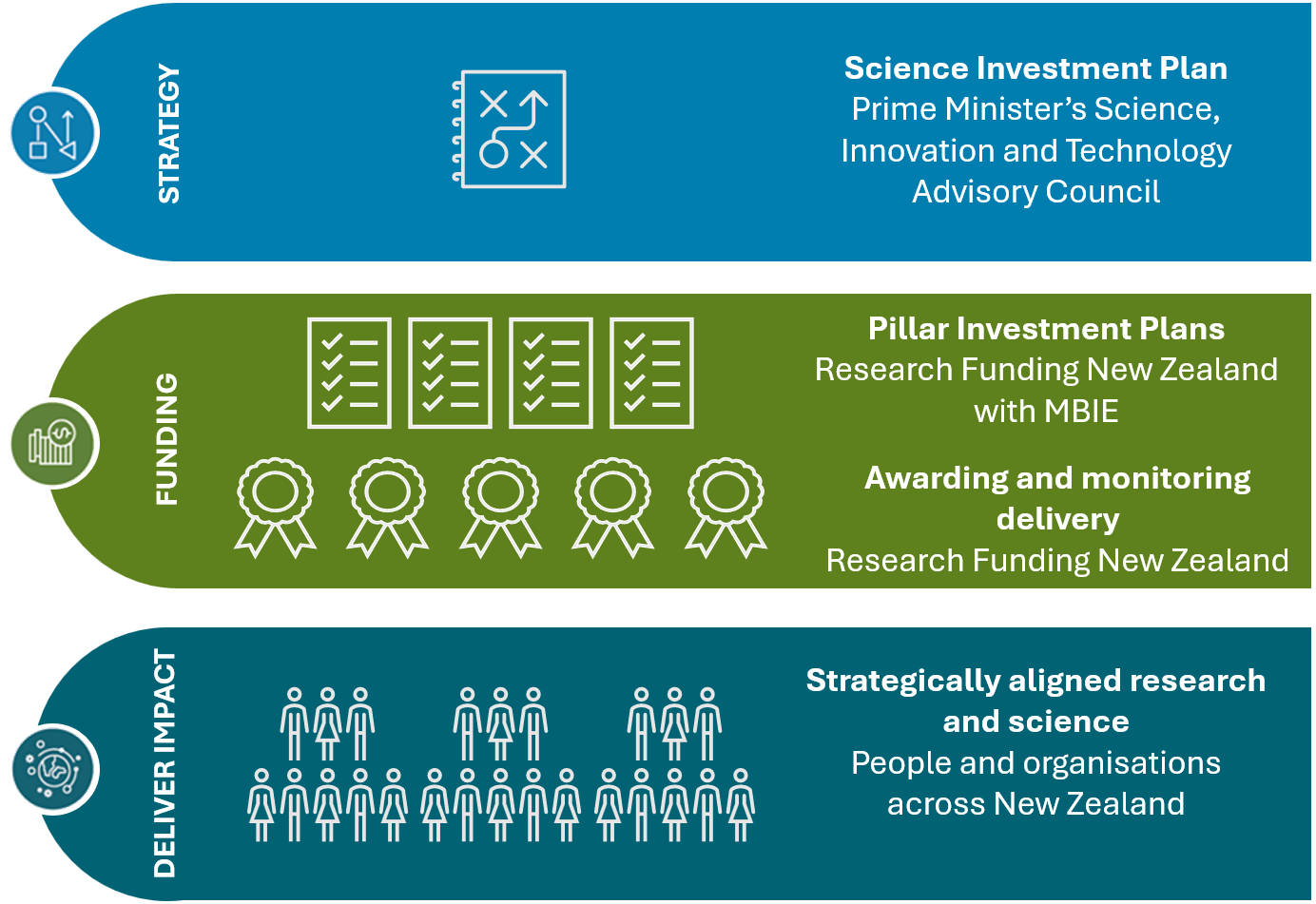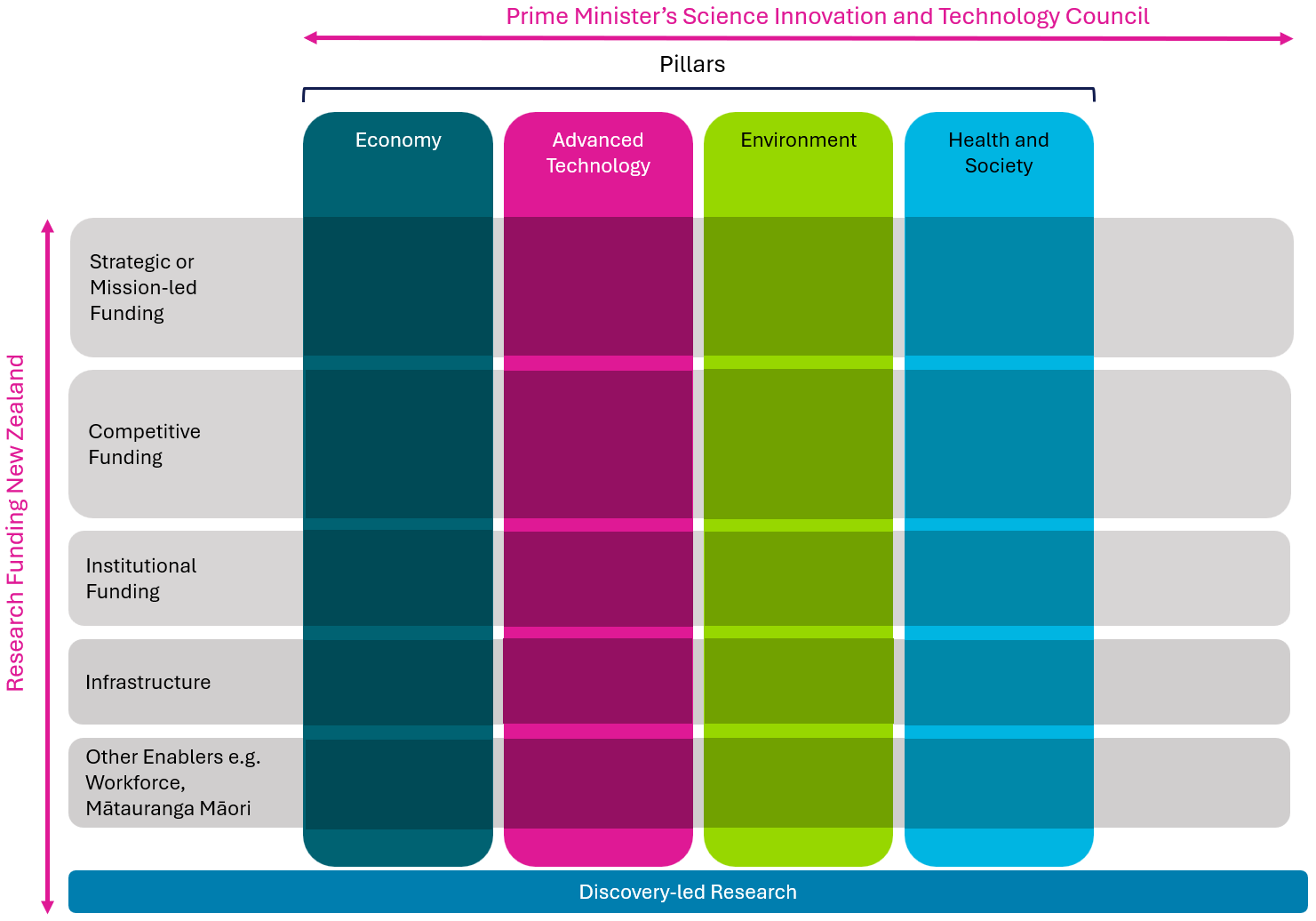A new funding strategy for the science system
The Government is changing how science, innovation and technology are funded and supported in New Zealand. The goal is a simpler and more strategic system that helps researchers turn ideas into solutions that benefit New Zealand.
On this page
The reforms will make the system easier to navigate and improve value for New Zealanders.
The Science, Innovation and Technology system future state has:
- A clear strategy focused on driving economic growth and delivering for New Zealand.
- Funding directed to delivering on research priorities and incentivising commercial outcomes.
- Institutions and individuals more strongly incentivised to deliver growth to the New Zealand economy and value to the private sector.
How the strategy works
There are 2 key changes:
- A new outcomes focused funding framework will be built around 4 pillars, so funding is directed towards what is most important for New Zealand.
- A single funding decision maker called Research Funding New Zealand (Research Funding NZ) will make most research funding decisions for the science, innovation and technology system.
The Prime Minister’s Science, Innovation and Technology Advisory Council will advise on research priorities for science funding. This advice will inform a Science Investment Plan that will set out strategic research priorities and align public investment with long‑term government goals.
The Science Investment Plan outlines the “what” – system wide research priorities and allocations.
Research Funding NZ will advise on Pillar Investment Plans which will be operational documents for each pillar.
The Pillar Investment Plans set the “how” – actions to deliver on these research priorities and informs Research Funding NZ on awarding decisions.
Flowchart showing 3 stages of New Zealand’s science investment process

Text description of flowchart showing 3 stages of New Zealand’s science investment process.
The new funding framework: 4 pillars
The new funding system will be organised around 4 pillars to give greater transparency about the focus and impact of science and research, and greater connection to research priorities.
They will be based around the economy, advanced technology, environment, and health and society.
The pillars are high-level and broad domain areas for funding. Each pillar will use a mix of tools that can include contestable grants, mission‑led research platforms, strategic capability‑building schemes and infrastructure support.
Strategic investment plans for each pillar, called Pillar Investment Plans will be developed with Research Funding NZ, based on research priorities guided by advice from the Prime Minister’s Science, Innovation and Technology Advisory Council.
Discovery-led science and research will continue to be funded. This will not just be restricted to within the pillars and is essential for maintaining a vibrant, curiosity-driven science system.
New Zealand’s research funding structure

Note this diagram is indicative as policy work progresses.
Text description of New Zealand’s research funding structure
Research Funding New Zealand
Research Funding NZ will be the single, independent decision maker for most government science, innovation and technology funds. This will make the system simpler and fairer because researchers will deal with one funding decision maker across the system.
Research Funding NZ will:
- make funding decisions
- provide advice on fund design
- advise on operational strategy for the funding system
- monitor investments against the agreed strategy.
It will initially replace the Marsden Fund Council, MBIE’s Science Board and MBIE’s funding roles, and will later bring in the Health Research Council, subject to further work. It is expected to be operating early in 2026 to make final awarding decisions on the next Marsden Fund round. Board members will be appointed in the coming months.
Read more about:
Funding system transition timeline
The transition will be gradual over the next four years to minimise disruption, starting with contestable funds Marsden and Endeavour and new investments of the Strategic Science Investment Fund in 2026. Funding rounds will continue during the transition so researchers can keep working.
All existing research contracts will continue with no change.
The Health Research Council operates under the Health Research Council Act. Further work is needed on the next steps to bring health research within Research Funding NZ’s remit.
More work will also be done on a national research infrastructure roadmap and a full‑cost funding model for Public Research Organisations to support critical public good science.
Transition breakdown by fund:
Endeavour Fund:
- All existing Endeavour Fund contracts continue with no change.
- For the 2026 round, in lieu of an open round, existing contracts coming to an end have been invited to apply for a one-year extension.
- We are working through the details of any changes to the funding round for 2027, which would usually open for applications September 2026.
- Changes will be guided by the Science Investment Plan and the Pillar Investment Plans.
- Final decisions about investment process will be made by Research Funding NZ.
- We will signal any changes to the fund well in advance.
- Our intention is to invite applications for a 2027 investment round.
Marsden Fund:
- All existing Marsden Fund contracts continue with no change.
- The 2026 Marsden round is underway. The Royal Society Te Apārangi has provided key information for the 2026 round, including:
- Allocation of approximately $55.8 million for new grants.
- No Marsden Fund Council Awards will be offered in 2026.
- More information will be published in the Expression of Interest guidelines, expected in early December 2025.
- The Marsden Fund Council will assess applications, but it is expected that the Marsden Fund Council will refer funding recommendations for the 2026 round to Research Funding NZ, who will make the final funding decision.
- Research Funding NZ will make future funding decisions.
- For future rounds, administration of the Marsden fund will move to MBIE. Decisions have not yet been made on the ongoing management of contracts.
Health Research Council:
- All existing contracts continue with no change.
- There is no plan to suspend funding rounds, however this is an operational decision for the HRC.
- Operational continuity is a priority, and any changes will be communicated well in advance.
Catalyst Fund and Horizon Europe:
- There are no changes to the decision maker for the Catalyst Fund and Horizon Europe.
- All existing Catalyst Fund research contracts continue with no change.
- Some Catalyst Fund programmes are devolved to the Royal Society Te Apārangi and the New Zealand Health Research Council and administered under an MBIE funding agreement.
- There are no changes to the devolved nature of these programmes as a result of this announcement. Any changes to these devolved programmes will be well communicated in advance.
- The Catalyst Fund Investment Plan, released towards the end of 2024 will continue to guide investment decisions for the Fund.
Strategic Science Investment Fund:
- All existing research contracts continue with no change.
- Funding decisions about new platforms or reinvestments will be made by Research Funding NZ from 2026.
He Ara Whakahihiko
- The current 2026 round will continue as planned.
- It is expected that final decisions on projects to be funded under the current round for Rangapū Rangahau will be made by Research Funding NZ.
- Final decision on projects to funded under the current round for Ara Whaihua will be made by MBIE’s Deputy Secretary, Labour, Science and Enterprise, as outlined in the call for proposals.
- In future rounds, decisions will be made by Research Funding NZ.
Tāwhia te Mana Fellowships
- It is expected that the Royal Society Te Apārangi will continue to administer the Tāwhia te mana fellowships scheme.
Commercialisation Partner Network and PreSeed Accelerator Fund
- There are no changes to the administration of these funds.
Envirolink
- There is no change to the administration of this fund.
The technical assessment and business engagement aspects of Research Development Tax Incentive and Business Research and Development grants (formerly administered by Callaghan Innovation)
These do not fall under the remit of Research Funding NZ and will be administered within the Te Whakatairanga Service Delivery of MBIE.

